I am getting lots of questions about transplanting hydrangeas. This post should help answer most of them.
Transplanting hydrangeas follows the general rule for transplanting anything: do it in the season opposite of the one in which it performs, i.e., its “off season.” So if something blooms in the fall, transplant and divide it in the spring, essentially when it is dormant. For something that blooms in the spring, you move it in the fall. So it is with hydrangeas. Exactly when you transplant your hydrangea depends on when it flowers.
With hydrangeas, as with other plants, you have a choice whether to transplant early in the growing season (spring) or the fall. Keep in mind that early-season transplants will be much more dependent on you, the gardener, to provide sufficient water for the entire summer. If you don’t have some kind of automatic watering system, hand watering can get old very fast as the season marches on, especially if it is a dry one.
Here are some other general guidelines.
PREPARE THE NEW SITE
Once you have chosen the best site based on your hydrangea’s needs (allowing for sunlight, soil, drainage, and moisture conditions), dig the receiving hole first to be sure it can accommodate the rootball. I can’t tell you how many times I have hit “foundation” rocks (read GINORMOUS) that have thwarted my planting plans!
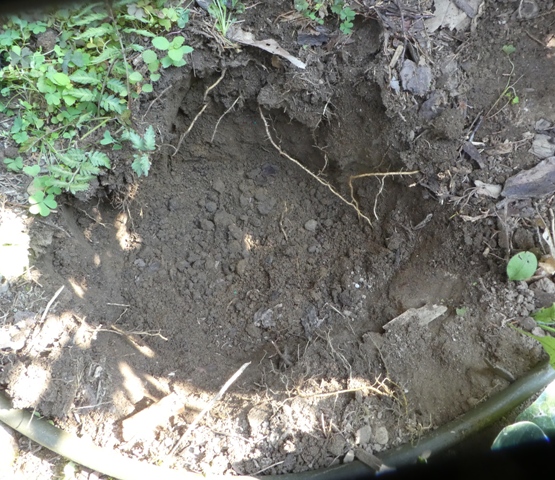
Dig the new hole first for your hydrangea transplant
If you’re okay on the receiving end, fill the hole with water and let it drain to be sure your drainage is adequate. If it empties in less than an hour, your hydrangea transplant will either die of thirst or you will be exhausted trying to keep it hydrated. This rapid drainage is an indication that your soil isn’t water-retentive and needs to be amended to hold moisture. Or maybe you need to pick a different site.
If it takes a few hours to empty, you should be okay to transplant your hydrangea into this hole. If it takes a day or more to empty, your soil is much too heavy in that spot. You will need to seriously amend it, or find a better site.
A GOOD TIME TO CONSIDER AMENDMENTS
You might want to do a pH test while you wait to ensure you have the right conditions for your plant. Analyze your results to get clear on what amendments you may have to add to bring that space up to standards.
Transplanting is traumatic for a plant so I always recommend using some sort of mycorrhizae additive in the fill soil. It helps reduce transplant shock and establish roots. Your local independent garden center can guide you to these additives. There are many choices on the market. Simply follow the label directions to help your hydrangea make a successful transition.
The only other amendments to add at transplant time are compost or composted manure and whatever you have decided to apply to adjust the pH, if necessary.
PREPARE THE HYDRANGEA THAT YOU’RE MOVING
Water the plant the night before moving it to ensure that it is well hydrated. Depending on the size of your plant, a wheelbarrow may be necessary plus some burlap and a tarp. A garden buddy for an extra pair of hands and a strong back will also come in handy.
If your plant is large and you want to keep it that size, wrap it loosely with a bungee cord or somehow tie it to keep it together. Some plants can open up and splay once they have been dug completely around their base at the drip line.
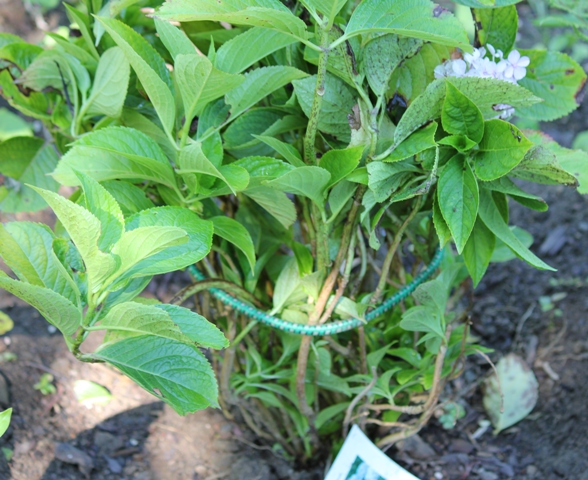
Hydrangea tied up with a bungee cord to keep it together before transplanting.
DIG IT UP!
Carefully use your transplant spade to gently dig around the edges of your plant at the drip line without actually digging it up. Then go deeper and start to coax the plant out of the ground. You are trying to keep as much of the rootball intact as possible. Slide the burlap underneath the plant and tie it around the rootball to keep it together. Now is when the plant might split, so you want to slide it onto that tarp and avoid actually lifting it. Here’s the moment when your garden buddy can help you as you either drag the plant over to the new hole or lift it into the wheelbarrow for transport.
MAKE THE MOVE
By now your newly dug planting hole should be ready to accept its new tenant. The water drainage has been tested, the proper amendments have been added based on your soil test, and your plant is good to go.
PUDDLING IT IN
Now “puddle the plant in.” “Puddling in” is a bit of a throwback to your childhood mud-playing days, except now it’s a useful planting technique. Put your plant into the very wet hole that has just finished draining. The hole might even have some water still in the bottom of it—with some of the backfill soil. Then water the plant and the backfill slightly to get a good muddy mix going. Tamp it slightly to remove the air pockets. Let that set for a bit, and then repeat that process until the plant is completely in the ground. It’s OK if there is a bit of water sitting at its crown that will slowly percolate down to the roots: your puddle. This process not only waters the plant well, but also eliminates air pockets during and after backfilling.
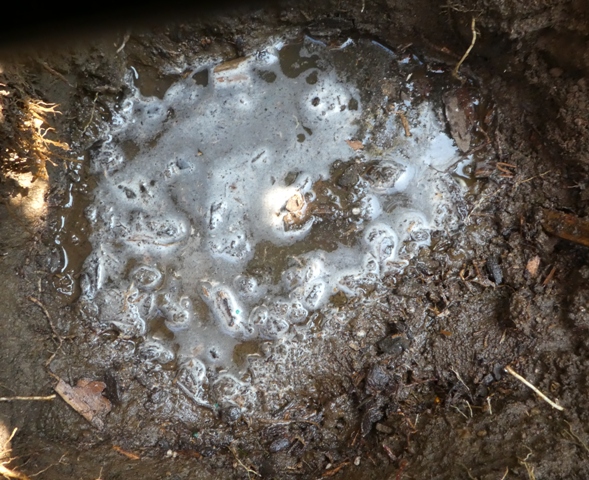
Receiving hole for transplant with water for “puddling in.”
Make sure the plant doesn’t sit deeper in its new hole than it was before you moved it. The only exception to this is if the plant had been heaved out of its previous spot for some reason such as burrowing creatures or freezing temperatures.
Amendments should be thoroughly integrated into the backsoil and the planting hole along with the native soil. No peat moss, Holly-tone, Miracid®, or anything else should be added at this time.
Create a firm soil collar about 2 inches high and about 4 inches out from the base of the plant to capture the water and allow it to be slowly absorbed by the soil. Or, better yet, lay a soaker hose a few inches away from the base of the plant so you can just turn it on to ensure your transplant gets off to a good start.
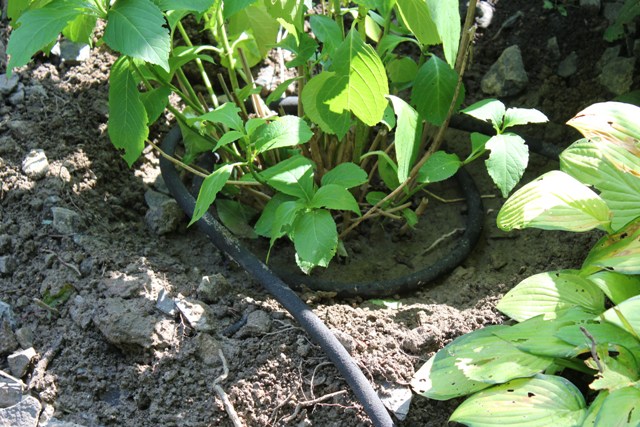
Transplanted hydrangea with soaker hose for irrigation
DON’T FORGET THE MULCH
The last part of the transplant process is to mulch your newly transplanted hydrangea. You want to put down a 2- to 4-inch layer of mulch like stones, wood chips, shredded leaves, cedar mulch, etc. The kind of hydrangea you have and where you moved it to will determine the proper mulch. There is a chapter on mulching in my book Success With Hydrangeas that gives specifics on what type of mulch is best for each kind of hydrangea. Mulch will keep the soil moist and protect the roots. It also helps to keep the soil temperature even as your plant goes into dormancy and experiences seasonal ups and downs.
CARING FOR YOUR TRANSPLANT
Keep a close watch on your plant after you move it to be sure it gets enough water as it heads into dormancy. If you move it in the fall, especially after it has lost its leaves, you won’t be able to detect water stress as those new roots develop. Watch the weather, do some knuckle tests, use your rain gauge, and be ready to provide supplemental irrigation if there is a shortfall of natural precipitation.
During the following two summers your transplant may need a little more attention while those fragile roots are still getting established. A soaker hose at the plant’s base will help a great deal as long as you don’t overdo it. Be prepared to spritz the foliage if the plant wilts even if the soil at its base is moist to the touch.
Don’t be disappointed if your hydrangea transplant doesn’t flower on time for its next cycle. It needs to focus on establishing roots vs. flowers. That could take a full season to get established in its new home.
There’s more detailed information on transplanting hydrangeas in my best selling book, Success With Hydrangeas. You can get your signed copy by clicking HERE. An autographed copy makes an especially welcome gift for Mother’s Day.
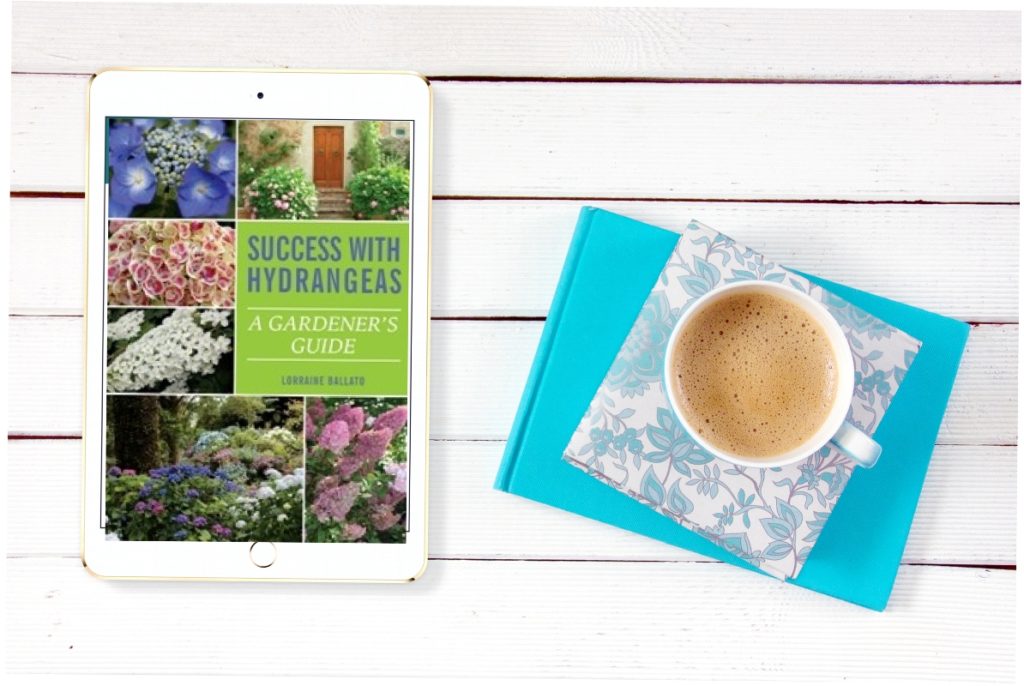
Book Success With Hydrangeas
6 Secrets for Stunning Hydrangea Flowers
Get my FREE mini-guide with 6 fool-proof tips showing how to grow hydrangeas that produce the most amazing flowers.
No spam - I promise!




